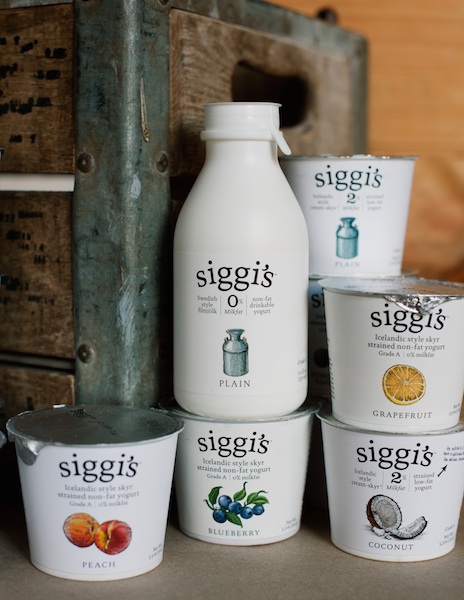In December 2004, Siggi Hilmarsson was homesick. It was Christmastime and, for the first time in his life, the 29-year-old Icelander wasn’t going back to his hometown of Reykjavik for the holidays. He had moved to New York two years prior to attend Columbia Business School and, freshly graduated, was working as a corporate management consultant. He wasn’t crazy about the job, and he wasn’t crazy about the sugary, processed foods in American grocery stores, but the gig gave him a reason to stay in New York, and that was enough —until Christmas.
Overcome by the urge to taste something that reminded him of home, Hilmarsson decided to make a batch of Icelandic strained yogurt, known as skyr, in his TriBeCa apartment. Little did he know where that sentimental experiment would take him.
Icelanders—bound by a geographically necessitated locavorism—have historically been expert at creating delicious, healthful foods from their frozen surroundings, and perhaps no mouthful embodies this sentiment better than skyr. It’s fat free but ultra-thick, smooth with a sophisticated tang and surprisingly high in protein.
The yogurt, for all its exotic appeal, is fairly simple to make. Centuries ago, Icelandic farmers started straining the skim milk left behind when they made butter. They incubated the skim milk with cultures and separated the whey, which was then used to pickle Icelandic vegetables. What remained of the dairy was a thick, low-fat, high-protein yogurt that kept for weeks, even before modern refrigeration.
When Hilmarsson started making skyr in his apartment, he followed a recipe from a ’60s-era Icelandic ladies home magazine: Boil skim milk, add cultures, incubate the mixture until it turns to a gel and then drain in cheesecloth, which thickens the mixture even more. “It did not taste great,” Hilmarsson recalls of the initial attempt, but he kept at it, undaunted, making batch after batch in his apartment, tinkering. It wasn’t working. “I had to figure out how to make it for real,” he explains. After weeks researching skyr history and modern manufacturing, he decided to schedule a session at a professional dairy plant. Thus began his determined dairy odyssey.
He found a small agricultural college in Morrisville, New York, that rented its dairy operation out to entrepreneurs. He cashed in a vacation day to drive up, homemade diagrams in hand. There, for the first time, he made a batch using proper equipment and laced the final product with agave nectar, hitting the proverbial not-too-sweet spot. Upon tasting it, the businessman within him suddenly awoke and realized he might be able to sell the stuff.
He departed the plant with a few hundred cups and passed them out to friends, which happened to include a big cheese: a vice president at Murray’s, who took a sample to a buying committee at the legendary store without telling Hilmarsson. The first he heard of it was when he received an e-mail from Murray’s that they would stock his skyr if it were commercially available. Meanwhile, a former professor of his offered to invest in Siggi’s skyr, should he choose to pursue it as a business. “I figured, ‘I’m young, I really don’t like my day job, I have someone willing to give me funds and someone willing to stock it,’” says Hilmarsson, visibly excited at the memory. “You really can’t ask for a better start.”
So he quit his day job and devoted himself to skyr full-time, naming his fledgling company the Icelandic Milk and Skyr Corporation and moving operations to a larger kitchen in Norwich, New York. In search of a superior milk supply, he got in touch with several small, family-run dairies near Norwich and started buying hormone- and antibiotic-free skim milk from their grass-fed cows. The farm closest to the plant is all of one minute away.
Siggi’s grew quickly. In 2006, he started selling cups at a downtown farmers market, and soon several of the city’s elite dairy retailers caught on—Dean & DeLuca, Zabar’s, Saxelby Cheese—all intrigued by Siggi’s dense texture and sophisticated flavors (orange-ginger and pomegranate-passion fruit, to name a few).
In 2007, a Whole Foods buyer tasted Siggi’s skyr and decided to carry the cups—nationally. The overnight demand posed the sort of problem that every small business alternately dreams of and dreads. “It happened so fast, it was ridiculous!” laughs Hilmarsson. “It just blew me away.” He had to shut down his entire Norwich kitchen and rebuild the space to skyrocket the skyr supply, but eventually was able to build one of the first strained yogurt plants in the country, where he could quadruple-strain the yogurt with specialized equipment (the watery leftovers are fed to the nearby pigs—“they love it,” he says).
Whole Foods, for their part, is happy to work through his growing pains. “Siggi’s is really a proud local success story for us,” says Michael Sinatra, Whole Foods’s Northeast public affairs manager. “It has everything we look for in a product: it’s local, it’s very high quality, it’s interesting and a little bit different than what our shoppers are used to, and it tastes great.” And, Sinatra adds, it’s flying off the shelves. “If he has some hiccups on the road to ramping up, of course we’ll work with him—we want to bring skyr to as many bowls as possible.”
Today, the cups are available at every Whole Foods in Manhattan and many around the country, and Hilmarsson’s expanded from a one-man apartment-based operation to the founder of a 30-person company that produces up to 100,000 cups of skyr a week. At his Flatiron office, about a dozen people handle sales and marketing, and his hunger for a taste of home is surely sated: Hilmarsson himself still taste-tests every batch that comes out of the plant, every week, without fail.
Photo Credit: Michael Gross



